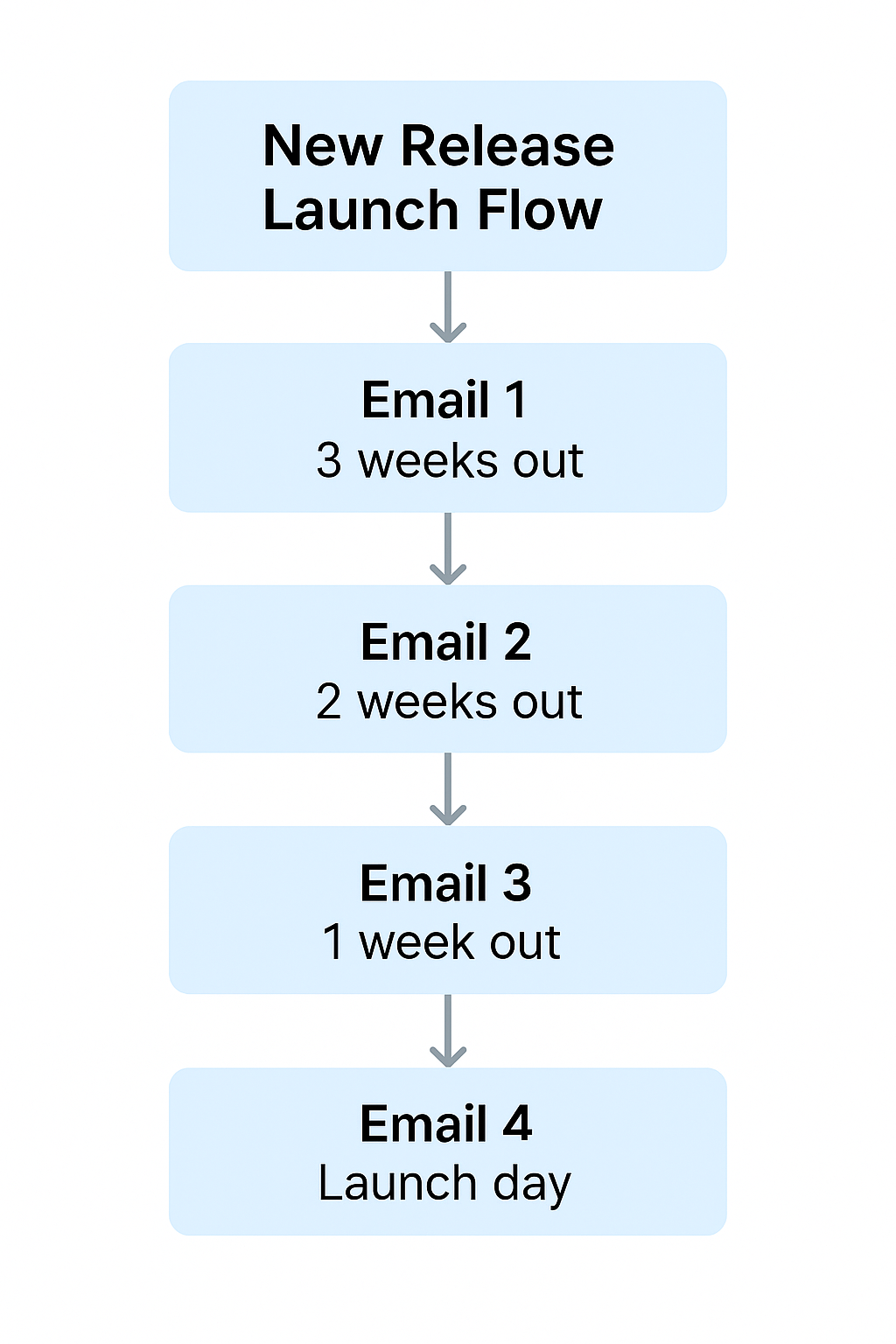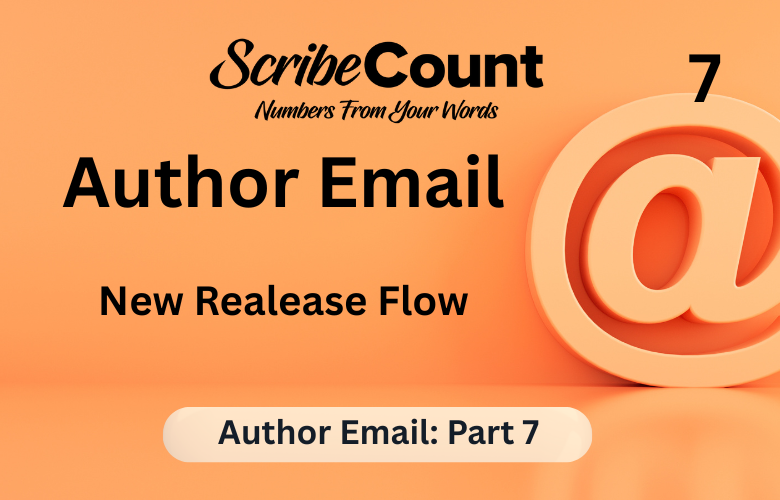New Release Flow for Indie Authors: Launching Your Book With Maximum Impact
Your launch sequence is your book's digital red carpet—a carefully planned, professionally executed rollout that makes your readers feel like they’re part of something big. After months (or even years) of writing, revising, formatting, and preparing your book, it’s not enough to simply upload the final files and cross your fingers. You need to make a splash, and there’s no better way to do that than with a structured, automated New Release Email Flow.
This guide will walk you through everything you need to know about crafting a high-converting, relationship-building launch campaign. Whether you’re releasing your first book or your fifteenth, a New Release Flow helps you create excitement, drive preorders, boost early reviews, and most importantly—connect with your readers in a way that feels authentic and memorable.
What Is a New Release Flow?
A New Release Flow is a series of strategically timed emails sent to your mailing list before, during, and after the launch of a new book. These aren’t generic email blasts. They’re crafted messages that deliver a narrative experience, building momentum while informing readers and prompting them to take action.
Each message in the sequence has a purpose: to tease, to announce, to celebrate, to thank, and to invite. Done right, the flow becomes more than a promotion—it becomes a story of your book’s arrival into the world.
Let’s define the typical goals of each message:
- Reveal your new title and cover to create intrigue and visual excitement
- Share a bonus or sample to give readers a taste of what’s coming
- Drive preorders and purchases at the moment of peak interest
- Request early reviews once readers have had a chance to dive in
- Follow up with one final reminder and a hint of what’s next
The entire flow is designed to be automated. Once set up using tools like ConvertKit, MailerLite, or FloDesk, it works while you focus on engagement, social promotion, or taking a well-earned breather.
Why Indie Authors Need a Launch Flow
Too often, indie authors treat a book release like a one-day event. They hit "publish," send out a single email, and wait. But email open rates vary, inboxes get crowded, and a one-time message rarely converts well—no matter how good your subject line is.
Your readers need multiple reminders, told from different angles, at different times. A launch flow helps:
- Maintain visibility through a series of engaging messages
- Catch readers who missed the first email
- Offer value through sneak peeks and exclusives
- Segment engaged readers for future promotions
- Reinforce the sense of community among your fanbase
More importantly, a flow reduces your stress. By automating your campaign, you give yourself space to enjoy the launch—rather than scrambling to draft updates in real time.
Anatomy of a High-Impact Launch Flow
A five-email sequence is the most balanced and effective format for most indie authors. It spans about three weeks and covers every phase of the launch journey.
Email 1: The Reveal (2–3 weeks before launch)
This is your announcement. Unveil the cover with bold visuals. Tell readers what the book is about, when it’s coming, and where to preorder. Keep it short, snappy, and visual. This email creates that first spark of interest.
Email 2: Sneak Peek or Bonus (1 week before launch)
Offer something exclusive. This could be a sample chapter, a deleted scene, a Q&A with a main character, or even the opening scene read aloud. The goal is emotional engagement—get readers excited about your world and characters.
Email 3: Launch Day Blast
The most important email. Send it early in the day. Use a celebratory tone and strong call to action. Include your cover image, sales links, a personal message from you, and maybe a few reader quotes if you’ve already gathered early feedback. This is your green light moment.
Email 4: Review Request (2–3 days post-launch)
Thank readers who purchased and kindly request a review. Include links to Amazon, Goodreads, and BookBub. Mention how reviews help authors reach more readers.
Email 5: Final Reminder (5–7 days post-launch)
Circle back to those who haven’t acted. Offer a limited-time deal or bonus download. Hint at what’s coming next in the series. This email should create urgency but also closure.

What to Include in Each Email
Your messages need more than just text. Visuals, personality, and clarity all play vital roles in performance.
- Use clean, high-resolution images of your book cover. Feature it prominently near the top.
- Include buy links twice. Don’t bury them. Put them near the top and bottom.
- Write a personal note. A short paragraph explaining why this book matters to you creates connection.
- Include social proof. If you have ARC blurbs, early reviews, or endorsements, feature them.
- Add value. Bonus content like playlists, timelines, or artwork increases engagement.
All content should reinforce the book’s themes and tone while staying true to your author voice.
Tools That Power Your Launch Flow
Technology is your ally. Here are tools that make automation easy:
- ConvertKit – Excellent for visual automation and segmentation
- MailerLite – Affordable and easy to use
- FloDesk – Beautiful templates with flat pricing
- ActiveCampaign – Great for advanced logic and behavior-based flows
- Klaviyo – Especially good for ecommerce and direct sales authors
For distributing ARCs (Advanced Reader Copies):
- BookFunnel – Trusted delivery and reader tracking
- StoryOrigin – ARC tools plus newsletter swaps and list building
Most platforms support tagging, split testing, and analytics. This means you can monitor who opened, who clicked, and adjust accordingly in future campaigns.
Mistakes to Avoid
Many indie authors unknowingly limit their launch impact with these common missteps:
- Only sending one email: Readers are busy—one shot isn’t enough.
- Weak subject lines: Clarity and excitement are key. Don’t be cryptic.
- No clear CTA: Every email should tell readers exactly what to do next.
- Missing links or images: Double-check formatting. Broken links can sabotage your launch.
- Waiting too long: Write and schedule the whole flow before your book goes live.
Avoiding these mistakes gives your book the best chance to succeed from day one.
After the Launch: What Comes Next?
Once the launch window closes, don’t let your reader engagement die off. Transition subscribers into:
- A long-term newsletter welcome series
- A thank-you and follow-up flow for buyers and reviewers
- A new reader magnet flow tied to your next title or backlist
You can also use subscriber tags to identify and group readers by behavior:
- Who clicked but didn’t buy
- Who bought but didn’t review
- Who reviewed and engaged heavily
These insights help you tailor your future marketing and build deeper relationships.
Final Thoughts: Launch With Confidence
A great book deserves a great launch. But you don’t have to rely on hype, luck, or last-minute effort. With a well-structured New Release Email Flow, you’re giving your book a professional launch strategy that works whether you’re online or offline, active or on vacation.
These flows don’t just sell books. They build trust. They turn one-time readers into lifelong fans.
So write the emails, load them into your ESP, hit schedule—and let the system do what it’s designed to do. Then get back to your next novel, knowing your launch is in motion.

